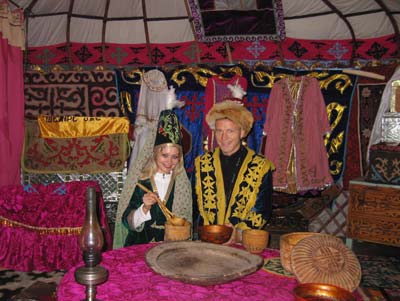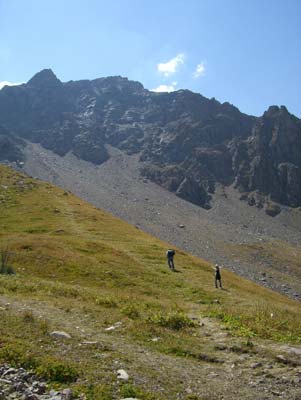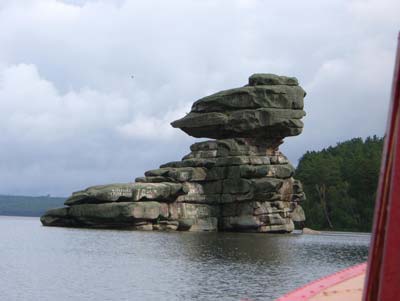Exploring Kazakhstan
by Aleutina Altenhof, Kassel, Germany
Traveling to the corner of the world once trodden by Genghis Khan had always been my dream. In August ’06 my spouse and I toured Kazakhstan, and it was a trip that overcame all my expectations.
Although Kazakhstan has neither palm-filled beaches nor luxurious hotels with views to the ocean, the vastness of its steppes and its other magnificent landscapes took my breath away. And if you are on the lookout for action and adventure like I am, Kazakhstan is the right place to go.
Astana, the heart of the country
Thinking back on my trip, I have never regretted that our journey started in Astana. This marvelous city in the northern part of the country became the capital of Kazakhstan only 10 years ago.
Yet today it boasts fashionable architecture, including modern government and business offices and cultural centers. When a friend of mine, Peter, who has lived in Kazakhstan all his life and who actually organized our trip, showed me earlier pictures of Astana, I couldn’t believe it was the same city I visited.
There are several eye-catching highlights in Astana, and we started with the most inviting one: Bayterek Tower, a landmark of the city and a symbol of the independence and prosperity brought about by the country’s president. This amazing architectural construction, erected on the left bank of Ishim, is 345 feet tall and crowned with a huge ball made of chameleon glass. It towers over the capital like a hand-created tree.
At the base is an aquarium, a restaurant and an art gallery, and inside the ball at a level of about 300 feet is a platform offering a breathtaking view of the city. On the upper part of the panorama deck is a silver plaque with the palm print of the president. It is said that if you put your own palm on it and make a wish, it is likely to come true.
After making a wish we visited some other area attractions, such as the ethnopark called Map of Kazakhstan, a unique outdoor museum, and the Duman entertainment complex, featuring an oceanarium, a 3-D movie theater, a casino, restaurants and cafés. But simply observing the fascinating architecture of this capital city was the thing that I enjoyed most of all.
Borovoye, the pearl of Kazakhstan
As an old Kazakh legend tells, when God created the world, one nation was bestowed with rich woody lands while another got beautiful mountains and lakes. What the Kazakhs got was feather-grass-covered steppes. Their feelings hurt, they asked God to give them a piece of natural beauty and God fulfilled their dream by generously covering a section of lifeless steppe with picturesque mountains, lakes of crystal-clear water and emerald meadows with flowers.
This natural oasis, today called Borovoye, was our shelter for five days. Although the resort is located not far from the capital (two hours by car), the harmony of silent lakes surrounded by mountains covered with pinewoods represents a sharp contrast to the boundless steppe landscape prevailing over nearly all of Kazakhstan.
What is remarkable is that each of the mountains resembles some kind of animal. If you look closely at the peaks, you can recognize an elephant, a rabbit or a snoring hedgehog.
The most famous spot in the region is probably the Blue Gulf on Borovoye Lake, with the mysterious sphinx-like rock known as Three Sisters rising from the water. Indeed, if you travel with a boat and observe the rock from different perspectives, you can see the face of a young lady with waving hair from one direction while from the other side the rock resembles the face of a middle-aged woman. From a third side you may clearly see the profile of a witch.
Staying at Samal (e-mail samalotel@mail.kz), a small resort hotel in the middle of the pinewood, was a real delight, too. Our double room cost $100 per night, and for around $40 we had two meals at their restaurant and spent one hour in the sauna.
Next was a unique trip to a real Kazakh village, located 20 miles away from Borovoye. I was surprised to see how Kazakhs used to live — in yurts. Inside, all the furniture was brightly colored and there were rugs on the walls and floor. Drinking gourds sat on a big dastarkhan (low, round table).
For Kazakhs, the yurt — a nomad’s round dwelling built on wooden poles and covered with handwoven textiles — has been the comfortable and practical home for centuries, as it can easily be taken apart and carried on camels or horses.
I was really impressed by the traditional custom among Kazakhs of inviting every guest to the table to try some Kazakh cuisine (and don’t you dare say “No”!).
For me, the natural beauty of Borovoye, coupled with fresh air and friendly Kazakh people, left the warmest and the most touching recollections. I now understand why locals refer to this place as “the pearl of Kazakhstan.”
Balkhash Lake
We tore ourselves away from Borovoye and traveled by jeep across the Kazakhstani steppe to the southern border of the country.
Shortly after we left the resort, the woody landscape was suddenly replaced by a dry steppe region. Soon we reached Karaganda, the second-largest city in central Kazakhstan. In comparison to Astana, Karaganda is an old city and therefore represents an absolute contrast to the capital. But I enjoyed its mix of old and modern architecture and green park avenues.
As we drove farther down the map of Kazakhstan, the beauty of Balkhash Lake unfolded. Actually, at 380 miles long and an average of 27 miles wide, it could pass for a small sea.
This remarkable lake consists of two different waters: the western basin containing fresh water and the eastern, salty. This certainly may explain the changing flora and fauna we saw as we drove beside the blue waters. The first 125 miles was populated with willow, rush and reed jungles inhabited by hares, foxes and wolves. In the northern part, I was amazed by the mountain range, Bektuata, an oasis with wonderful rocks and gorges.
As Peter told us, Balkhash is also home to cormorants, teals, pheasants and swans and is surprisingly rich with fish such as trout, catfish and bream.
Of course, how could I visit Balkhash without bathing in its salty waters? After spending hours in a car, swimming was such a delight — especially under the hot sun.
Almaty
It was late at night as we reached our next destination, the city of Almaty, located in the foothills of the picturesque Tien Shan Mountains.
I have never seen a place like Almaty before. The city extends about 12½ miles in all directions from its center and features numerous boulevards, city parks and apple orchards; the latter are a symbol of the city and occupy 20 acres of Almaty’s territory. It was a green paradise, rare for Kazakhstan!
Here and there, theaters, museums, stadiums, restaurants, casinos, business centers, hotels and art galleries displayed the versatility of life in Almaty. Surrounded by the beautiful mountain range, the city can be proud of its unique climatic conditions as well.
The next day we ascended, first by car and then on foot, to the high-altitude sport complex Medeo. Located at 5,500 feet above sea level and between the mountains covered with pinewood, Medeo is a popular skating rink and also serves as a concert pavilion for international music festivals. I was mesmerized by this magical location.
Via cable car we reached another wonderful section of Medeo, which offered a splendid panoramic view of untouched green valleys covered with meadows, streams and flowery fields.
We spent a total of two weeks in Kazakhstan and it was a journey full of unexpected events. Now I am longing to see this remote corner of the world again.




